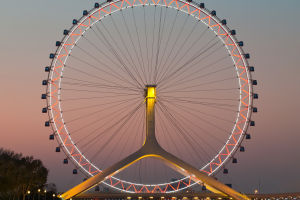Mountain biking is the activity of riding a bicycle on different kinds of off-road trails. It requires endurance, speed, balance and technical skills to navigate through rough terrains. Unlike road bikers, mountain bikers pursue obstacles and see the world as a natural and challenging playground full of winding trails. Vertical downhill sections, steep ascents, loose rocks, water crossings, tree roots: everything is an opportunity to put their abilities to the test!
Mountain biking is a dynamic sport that involves a total body workout. On a ride you not only work out your legs and strengthens your heart and lungs, but also exercises your upper body (when climbing with your bike or maneuvering with your arms). Cycling also boosts riders' balance, coordination and stability.
Types of Mountain Biking
Trail riding is a recreational form of cycling. It’s all about a pleasurable ride on marked trails, including uphill and downhill sections.
Cross-country cycling (or XC) is the most popular discipline of mountain biking and also the less extreme. It consists on completing a defined round circuit or point-to-point long trail, on a terrain that can range from a single track ―a narrow trail to fit one rider at a time―, to fire roads or even paved roads. There are technical sections defined by either natural or man-made obstacles. The sport requires endurance and very good bike handling skills, but it does not focus too much on speed. The bikes used for cross-country cycling are lightweight.
Downhill biking is a thrilling type of mountain biking, which focuses on descending a trail at a very high speed. Usually, bikers reach a mountain peak by using a car or a lift, and then race down on their bikes. Ski resorts during summer months are an ideal setting for this. When riding downhill, bikers are standing up, so the workout is very much tiring. Downhill bikes have a full suspension, are heavier than cross-country bikes and specially prepared for high-speed descents.
All mountain combines the best of two worlds: cross-country cycling and downhill. It implies riding on a natural terrain full of obstacles, either up a mountain and downhill.
‘Enduro’ refers to a specific competition born in Europe, which consists on different stages that a rider has to complete, including both uphills and downhills. It’s the same as ‘all mountain’ except for the fact that you are racing.
Equipment we need for Mountain biking are
* Mountain bike. As we mentioned before, there are different types of bikes (downhill, enduro, cross-country, etc) depending on the cycling discipline you are up to. Some other terms you may hear in the mountain biking world are: ‘fat bikes’, which are especially useful for riding snowy trails and also on sand and mud; ‘E-Bikes’, a regular bike with a battery-powered motor to make pedaling easier. E-Bikes are rising their popularity all around the world, specially among less-frequent riders.
* Mountain bike helmet. Never, ever, ride without a helmet! There’s a high risk of falling when mountain biking, so head protection is key. The characteristics of the helmet will be different depending on the type of cycling. Downhill biking, for example, is considered extremely risky so it requires a maximum protection.
* Knee pads, elbow pads and riding gloves.
* Footwear. Waterproof shoes, with good grips for hiking and comfortable for using the bike’s pedals.
* Protective glasses.
* Hydration packs are commonly used for mountain biking. Another items you can take include food, an aid supply, sunscreen, maps or GPS, extra clothing and a bike-repair kit.
Top spots for mountain biking in the world
1.French Alps. From the iconic Tour du Mont Blanc to incredible mountain biking trails in the Ecrins, Queyras or Vercors, the French Alps provide endless terrain for those who enjoy cycling!
2.Julian Alps (Slovenia). Slovenia boasts is an exciting bike-friendly country, with hundreds of marked cycling routes on beautiful mountain settings. Bled, Kranjska Gora and Triglav National Park are the top mountain biking locations.


